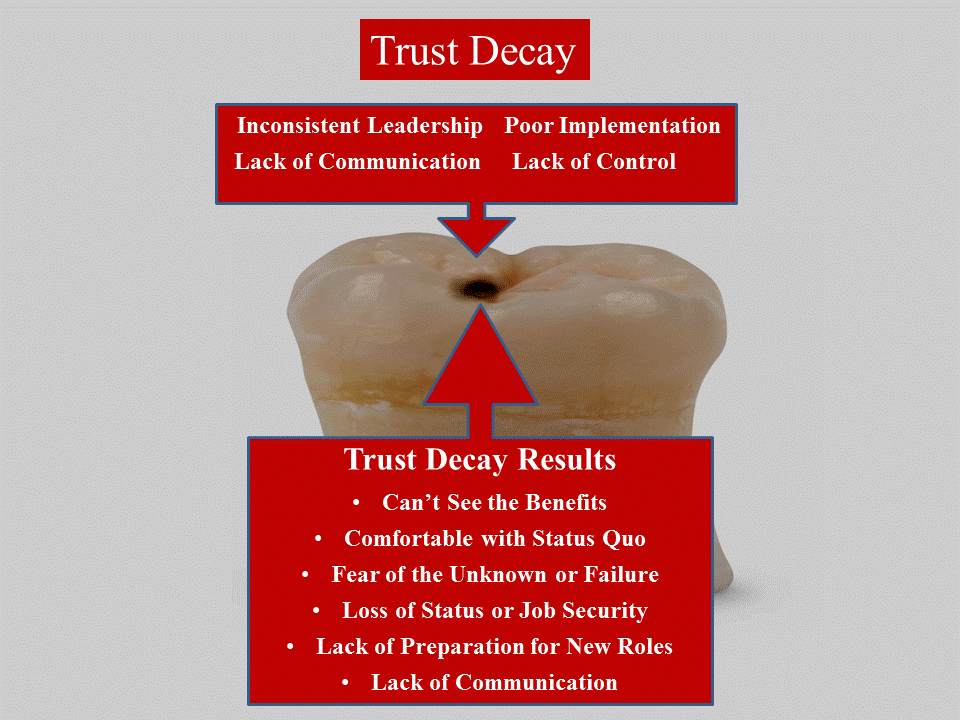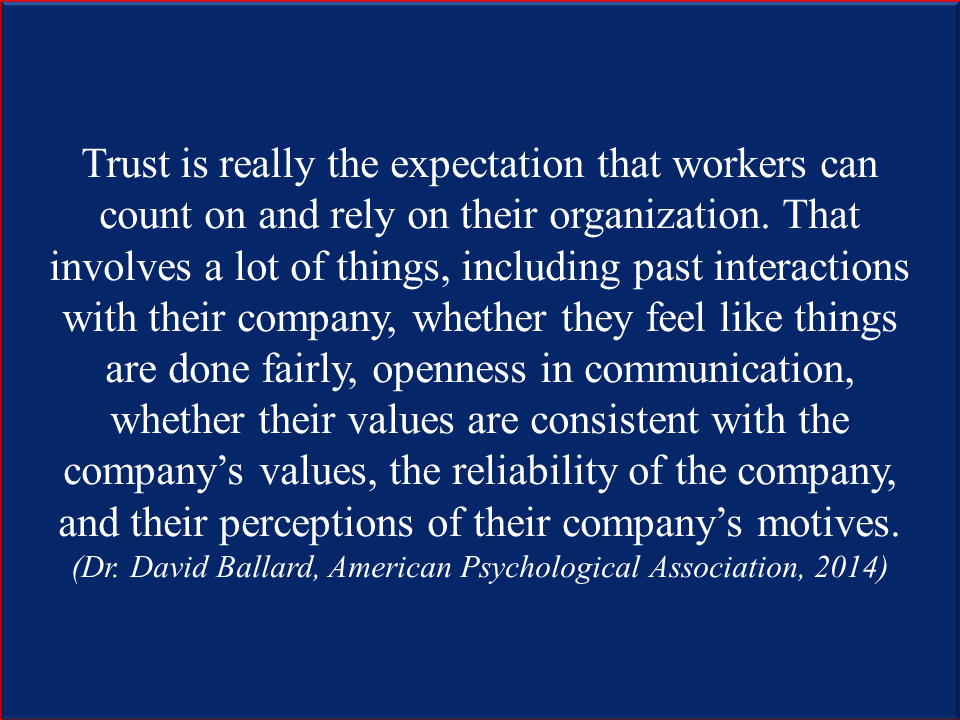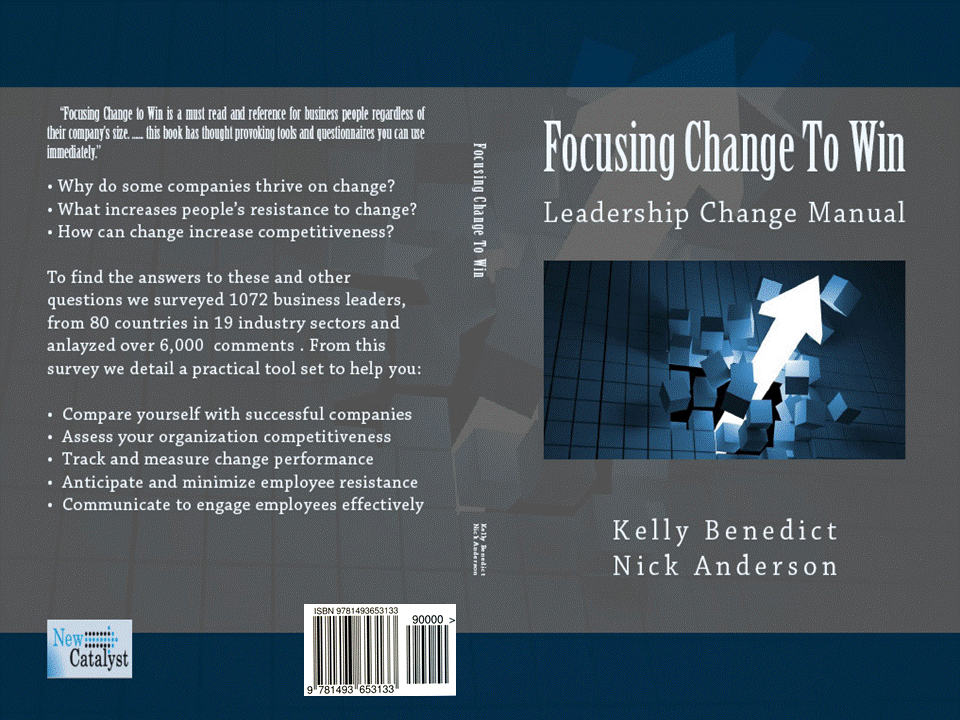Employee’s willingness to trust is under pressure. Pressure caused by manufacturing outsourcing, poor change communication and inconsistent leadership. The bottom-line is that “doing more with less” sounds macho in closeted executive strategy sessions. The reality is that those who do the work done feel the stress of over-work and insecurity that is steadily eroding their trust in leaders. Add to this the number of broken promises people feel leaders have made and you get progressive “Trust Decay”
In our survey, Focusing Change To Win respondents see the connection between poor leadership and change resistance
North Americans grow more cynical of being asked “go the extra mile” with even fewer resources. As a result, change resistance is increasingly more difficult.
This “Trust Decay” eats away at competitiveness. The leadership challenge how to repair, build and protect people’s trust. At the heart of this rebuilding process is reducing misalignment between all those involved in implementing a change.
In North America, we have conducted expectation alignment projects in very different organizations like Royal Bank of Canada, Qwest Telecommunications and Turner Construction. In every project, leaders consistently under-estimated the gaps between:
- What they expect of their people and what the people actually think is expected of them.
- What they think people expect of them and their people actually expect of their leaders
In all projects, leaders had 65%+ more expectations than their people were aware. The consequence is that:
More than half feel like their employer isn’t open and upfront, a third feel that their organization isn’t always honest and truthful. One in four say they don’t trust their employer at all, and that’s a big deal.
(American Psychological Association Work and Well-Being Survey, 2014)
Why does this matter?
Here’s a client example. You are leading a sales force that is winning only 1 out of every 10 bids against a major competitor. Analysis shows you need sell solutions not “boxes”. You can only do this by working consultatively both in your own company and with your customers to create competitive differentiation. For the last nine months you have “banged on” about this with account managers, sales engineers, field technicians and anyone who will listen.
We helped our client analyze his people’s expectations only to find that:
- He had 36 expectations of people to sell consultatively they only thought he had 5.
- He had 23 expectations of his people to collaborate in the pooling of client knowledge, planning account strategies and sharing the outcomes of client facing actions. Depending on the different groups their expectations varied from zero to 3
- There are also few expectations between the different groups
Trust levels between groups and the client were at an all time low. Is this typical? As you read on, you will see that my findings are disturbingly endorsed on both sides of the Atlantic.Here’s some survey findings from 2004 to 2014.
Trust Surveys from 2004
In 2004 a UK survey into employee attitudes by Chartered Institute of Personnel and Development (CIPD) showed trust in senior management is declining, particularly in the private sector:
- Only 25% of all employees are willing to place a lot of trust in senior management
- Disturbingly, 41% place little or no trust in senior management
“It takes more than personal integrity to build a trusting, trustworthy organization. It takes skills, smart supporting processes, and unwavering attention on the part of top managers.” (HBR, 2003, Feb – by Robert Galford & Anne Seibold Drapeau)
Now wind the clock forward to 2010.
The Right Management Group surveyed 4,000 US employees on trust levels within their organizations. The results showed an alarming employee trust gap threatening  longer term competitiveness. For example:
longer term competitiveness. For example:
When asked how often they trusted their managers to make the best decisions, employees responded:
- 20% always trusted their managers
- 57% occasionally trusted their managers
- 19% rarely trusted their managers
So, 75% all employees had low levels of trust in their managers!!!.
The employment compact is fractured. If employees do not trust their managers, how likely are they to give their best and “go the extra mile”?
They also found that trust levels declined the closer to the front-line you get.
- Only 31% executives always trust their managers’ decisions yet
- Only 22% for non-management employees trust their managers
- 15% Employees aged 18 to 24 years rarely trust their managers to make the best decisions.
- 27% for employees aged over 55 years rarely trust their managers to make the best decisions
And if you doubt that these findings aren’t damaging competitiveness, other studies show that poor manager-employee relationships breed poor customer relationships.
How are trust levels in your organization? If you were to run a similar survey, what do you think would be the results? What are you doing to improve trust levels in your organization?
Now to July 2011
Employees are still harboring a deep distrust of company management. A survey by Maritz Research found that the American workforce remains less trusting than in 2010. The major culprits being poor communication, lack of perceived caring, inconsistent behavior, perceptions of favoritism
According to the survey:
- 25% report less trust in management than they did last year.
- Only 10% trust management to make the right decision in times of uncertainty
- Only 14% of Americans believe their company’s leaders are ethical and honest
- Only 12% believe their employer genuinely listens to and cares about them
- Only 7% believe senior management’s actions are completely consistent with their words.
It is not only top management who have problems – trust in employee’s immediate line manager has also declined, dropping by over 10% over the past two years. Furthermore, fewer than half of respondents say their supervisor motivates them and only 37% say their line manager actually helps them improve performance.
“Employee trust is ….critical for success, especially given what the American workforce has faced the past several years. This data paints a dire picture of employee trust levels….A strong indicator of management mistrust is lack of shared values. Companies must align their …values …with…individual values of their people” Rick Garlick, Ph.D. , Maritz Research Group
“Every employee is unique. The sooner management realizes that a one-size-fits-all approach to engagement doesn’t work, the sooner they’ll start earning the trust of their people and driving business growth,” said Garlick.Is the Enemy of Trust at Your Gate – Misalignment
Many times a lack of trust is not immediately obvious. But, you know when the “Enemy is at the Gate” when you hear:
- “Why haven’t you done it?”
- “I thought you were doing that”
- “They never tell us in-time!’
- “Why are you doing that – it’s my job!”
They often stem from:
- Inconsistent Messages (with leader’s behavior especially)
- Inconsistent Standards – people perceive favoritism
- Misplaced Kindness – Managers not confronting incompetence and negativity.
- False Feedback – saying someone is doing great when they are not.
- Elephants in the room– the issue that no-one wants to acknowledge or talk about them.
- Rumors in a vacuüm – unfounded yet damaging
“Trust is a key element in the psychological contract between employers and employees. If employees have a positive psychological contract, this means they will show higher levels of satisfaction, motivation and commitment to the organization.”
Mike Emmett, CIPD Employee Relations Adviser
So, if employees don’t trust their employer, or don’t feel treated fairly – guess what?
Leaders need to work a lot harder to get the best from their people. Good communication is key – consulting people about change and ensuring they feel involved in the decision-making process – is basic good management. But too many firms are not getting the basics right. People are not clear or confident in what their leaders expect of them, especially in times of change
A Disturbing Conclusion of the Ultimate Enemy – Stress
Misaligned expectations are often a cause of stress which has huge costs in sickness absence, productivity and morale.
A recent report explored the characteristics of a high quality workplace. These are to do with the demands of the job, personal control, support from supervisors or colleagues, work relationships, clarity of role and degree of change in the workplace. The success of these dimensions has impact on levels of motivation, organizational commitment, satisfaction at work and customer loyalty. People who scored highly on these characteristics reported lower levels of work-related stress.
Managers need to make significant efforts to tackle the issues responsible for creating stress: basically issues about good management.
Companies are failing to confront the causes of work-related misalignment and resulting stress. This is not a “feel-good” issue about being nice. It is an issue of getting the best out of people. Dealing with stress improves performance, competitiveness and profitability
The need for leaders to make sure their people are aligned – on the same page. This means reciprocated understanding, agreement and commitment to expectations. It is obvious yet remains neglected. What is not so obvious is the need to elicit and respond to what employees expect in return. This should be a process, not a survey.
It is far more active and genuinely engaging than surveys or other passive methods. It needs to compare each employee’s expectations and their assumptions with others in the organization, on a specific change.
Such explicit and specific alignment of expectations and assumptions is the fundamental to building the transparency and consistency essential for a trusting environment. And a trusting environment is the very basis for productivity and competitiveness.
For Help in Getting Your People on the Same Page ask Nick Anderson, The Crispian Advantage
E-mail I Web I Linkedin I Call 1+ (616) 745-8667
[contact-form subject=”Feedback from pdsgroup.wordpress.com” to=”nanderson@thecrispianadvantage.com”] [contact-field label=”Name” type=”name” required=”true” /] [contact-field label=”Email” type=”email” required=”true” /] [contact-field label=”Industry” type=”text” /] [contact-field label=”Feedback” type=”textarea” required=”true” /] [/contact-form]
© Copyright All Rights Reserved, The Crispian Advantage and Walk the Talk – A Blog for Agile Minds, [2010-2012]. Unauthorized use and/or duplication of this material without express and written permission from this blog’s author and/or owner is strictly prohibited. Excerpts and links may be used, provided that full and clear credit is given to Nick Anderson, The Crispian Advantage and Walk the Talk – A Blog for Agile Minds with appropriate and specific direction to the original content.


